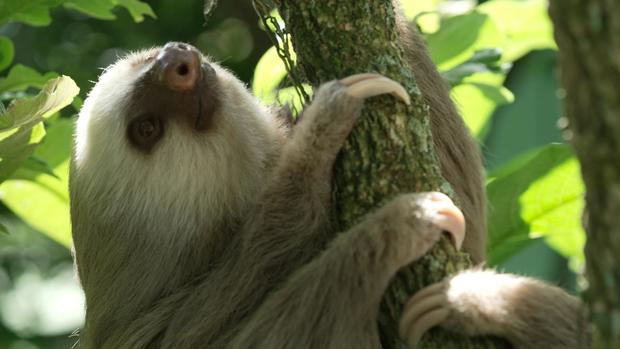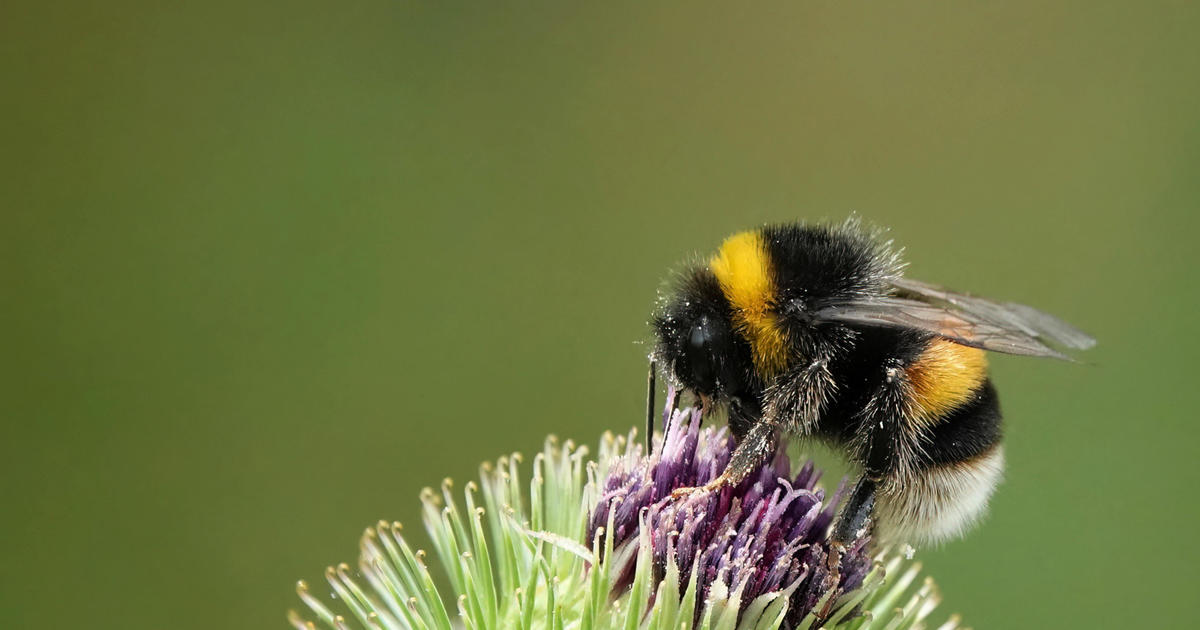Sloths may be threatened by climate change, human sprawl after 64 million years of evolution
Sloths, the world's slowest mammals, have evolved over 64 million years into a species that thrives throughout Central America and northern South America, but climate change and human sprawl could be threatening the species' survival.
Scientist Becky Cliffe is conducting the world's first-ever population study of sloths so she can determine just how much trouble the animal might be in. Cliffe said her staff is suddenly seeing fewer sloths and some are suffering from an illness she suspects may be related to climate change; sloths are starving to death even though they have full stomachs.
"We're getting extreme periods of hot dry weather, and then extreme periods of prolonged cold and rain. And that is not what sloths have evolved to survive in," Cliffe said. "What we're discovering is that the microbes in the sloth's stomach that they use to digest the leaves they eat, when the sloth gets too cold, those microbes die. So even though the sloth might be eating and looking well, it's not digesting its food properly. So they're losing energy and they're getting very weak."
For Cliffe to collect data, she has to collect sloths. The mammal, a master of disguise, can be hard to spot, even though neither of the two species in the country are considered endangered.
"They've evolved over the last 64 million years to be masters of disguise, right? They are so good at pretending to be coconuts and bird nests," Cliffe said.
They blend into tree canopy and can easily be mistaken for tufts of leaves. While that ability to conceal themselves may have helped the sloth survive for so long, it also makes it difficult for researchers and activists to help the mammal and gather the data they need.
Finding sloths is the full time job for one of Cliffe's colleagues. He climbs barefoot up stories-tall trees covered in biting ants to reach sloths, putting them in a bag and lowering them down. The team collects manual data, such as the type of trees the sloths live in. The sloths are also given a tiny backpack with a data logger that can record their micro body movements and behavior.
The sloths in Costa Rica have terrible eyesight and bad hearing, but it hasn't impeded their daily lives. Sloths have evolved in a unique way that turns the idea of survival of the fittest upside down. They're the slowest mammal in the world, topping out at a half mile an hour on the ground. They move so slowly that algae literally grows on them.
Being nature's couch potato is the reason sloths have survived for so long, zoologist Lucy Cooke said. She should know — she's written the book on sloths, or rather two of them. Cooke has observed and documented the strange lives of sloths for 15 years. What's hard for many to understand is that sloths are uniquely built to survive.
"They're saving energy. They're vegetarians, and leaves don't want to be eaten any more than antelope do, right? So they create a lot of toxins," Cooke said. "So the sloth can digest those toxins, but only very, very slowly. They don't want to process them fast. And so they're all about burning as little energy as possible."
They're solitary creatures and climb to the ground for a bathroom break just once a week. Descending from trees to go to the bathroom is a risk for sloths; the animal is vulnerable to predators while on the ground, Cliffe, the expert behind the sloth population study, wrote in a Sloth Conservation Foundation post. Scientists have struggled to explain why sloths will only go to the bathroom on the ground. Cliffe believes the sloths communicate via pheromones present in urine and feces. If the animals went to the bathroom from atop tree canopies, those messages could be lost.
Their trips to the ground aren't the only risk sloths face. Sloths' millions of years of unique evolution could not prepare the animal for human sprawl. Sloths spend about 90% of their life hanging upside down from vines and trees and sometimes suffer electrical burns after touching power lines while grabbing for vines in the forest.
At Toucan Rescue Ranch in Costa Rica, veterinarians treat sloths who've suffered electrical burns. The veterinarians believe sloths' slow metabolism plays a key role in recovery, allowing sloths to recover from injuries that might kill other creatures.
The Toucan Rescue Ranch also takes in orphaned sloths. It can take up to two years for the orphans to be released back into the wild.
Across the world, there are six different species of sloths. Costa Rica is home to two of those species – the Bradypus and what's known as the two-toed.
"The two-toed I always say looks like a cross between a Wookiee and a pig, because they've got that sort of beep-able nose. And then these ones [Bradypus] have the sort of, you know, Beatles haircuts and, and Mona Lisa smiles," Cooke said.
Learning more about the creature with the mysterious smile could yield some crucial insights for humans, too.
"We can learn how to be more slow and sustainable ourselves, because we need to. You know, we're destroying this planet at an alarming rate. And part of that is because of our addiction to speed and convenience," Cooke said.
"So if we took a few carefully, slowly, digested leaves out of the sloth's book, you know, we might, we might save this beautiful planet and all of the amazing creatures that live on it."
This story was reported by Sharyn Alfonsi, Guy Campanile and Lucy Hatcher.





